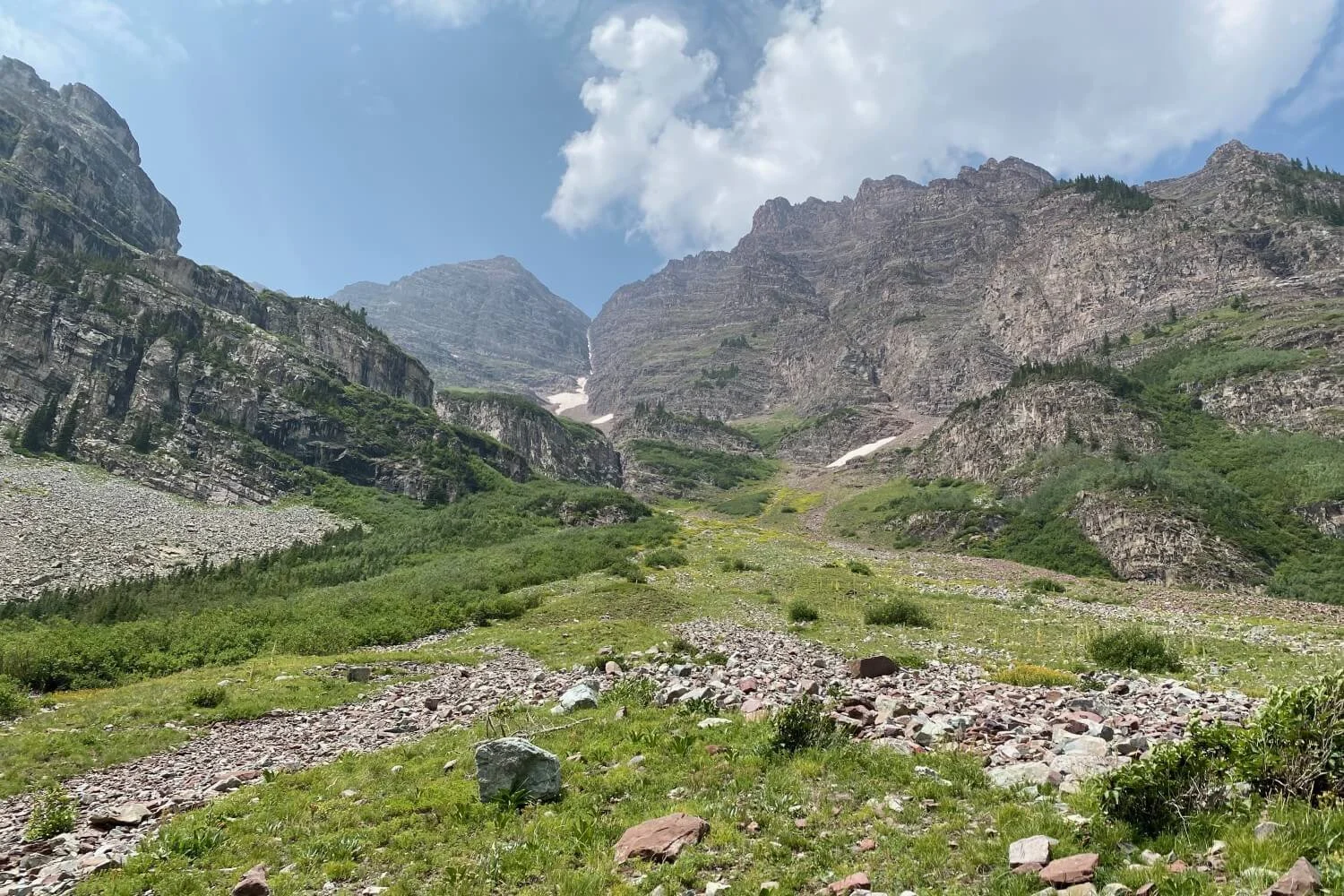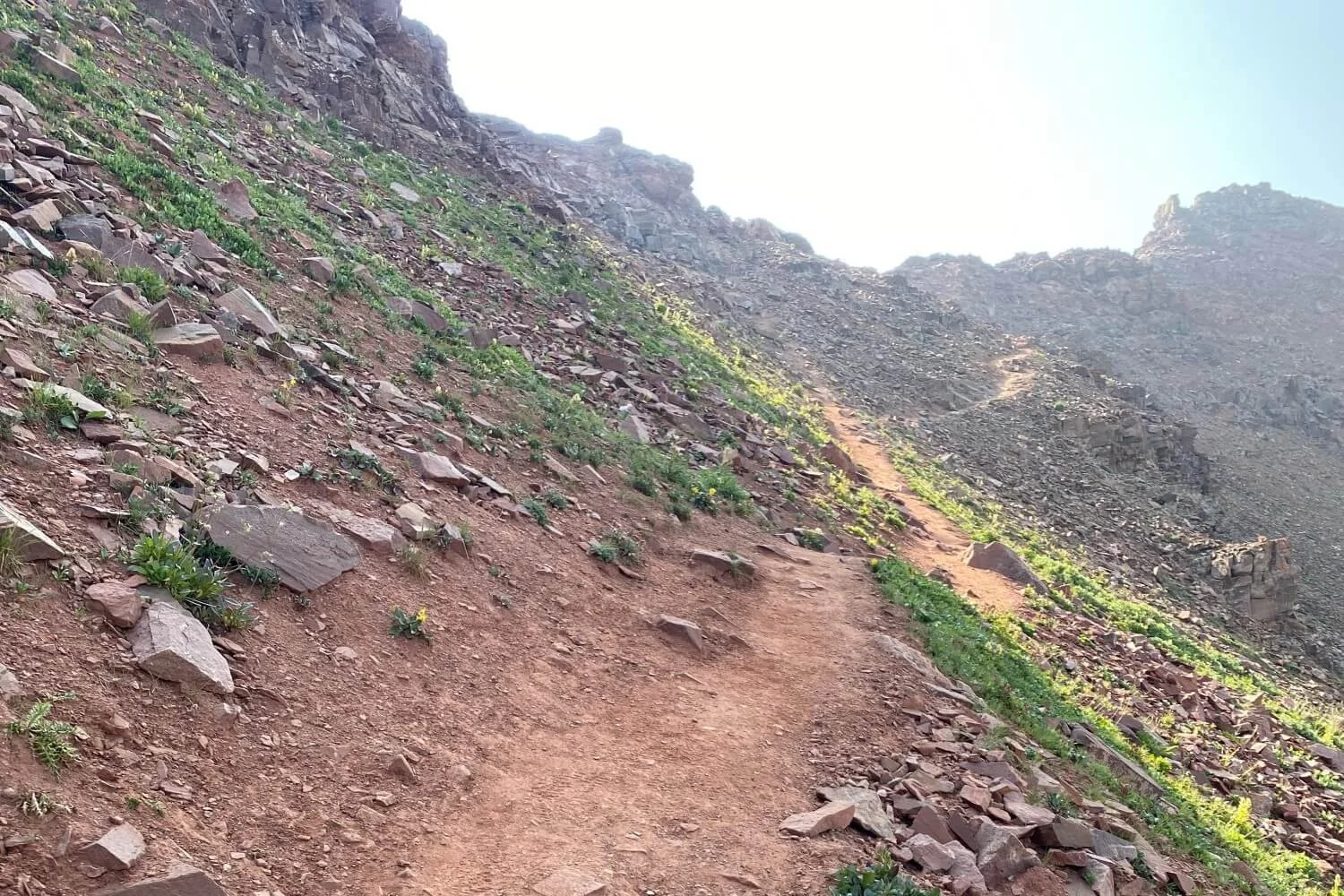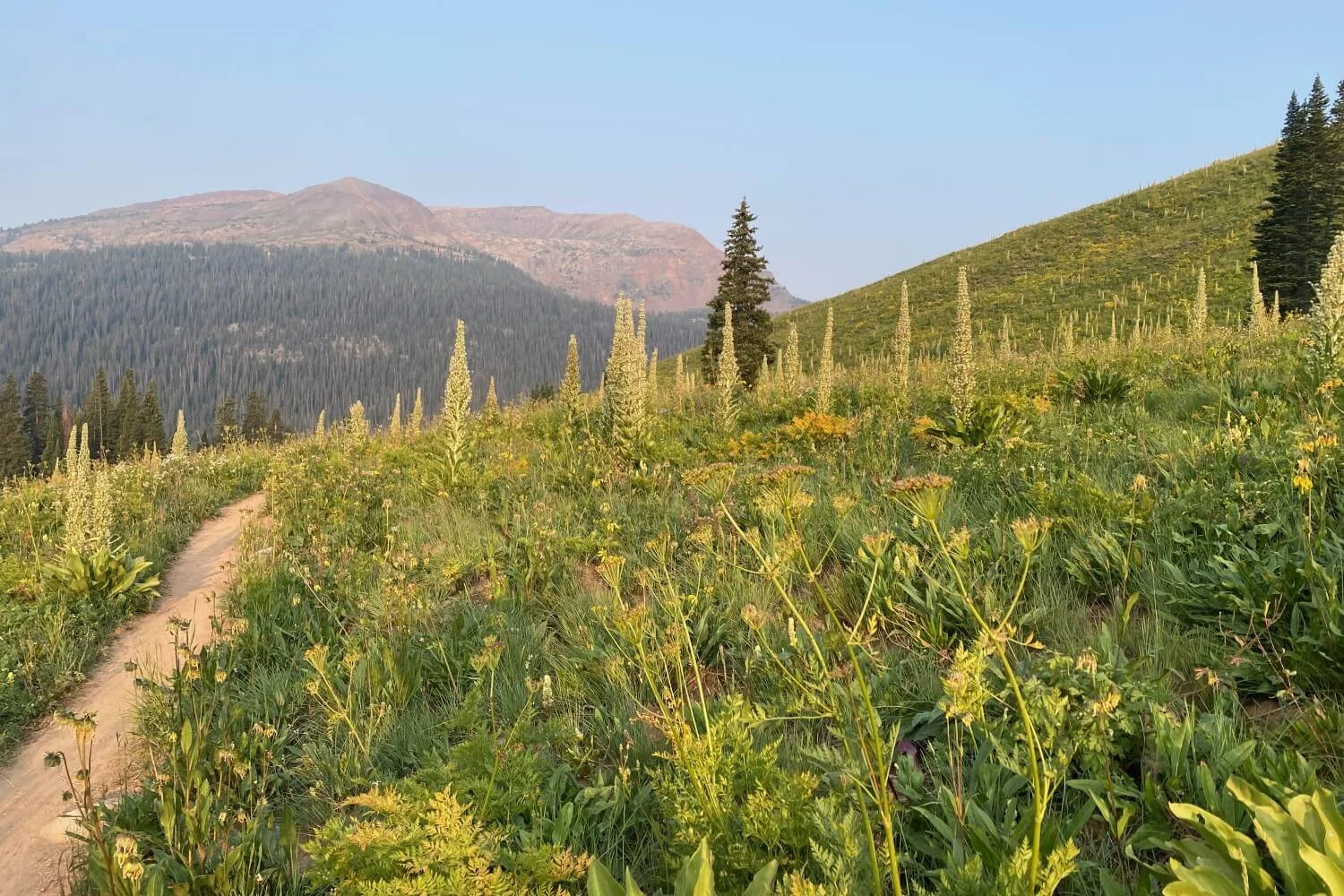Crested Butte to Aspen Hiking Guide for 2023
JUMP TO: PROS & CONS / ITINERARIES / WHEN TO GO / HOW TO GET THERE / CAMPSITES / NAVIGATION / WATER / WILDLIFE / TRAILHEAD SERVICES
The Aspen Snowmass Wilderness is a bucket list hiking destination for many people, and the West Maroon Trail is one of the real gems within it.
The West Maroon Trail takes you from Crested Butte to Aspen in a single day, crossing the West Maroon Pass on the way. Three 14ers (Maroon Peak, North Maroon Peak and Pyramid Peak) rise up out of the wildflower carpeted valley watching over the pass. Wildlife can be spotted along the trail, even rare glimpses of a few of the more reclusive animals like moose and black bear.
If you’re looking to extend your trip in the area, the West Maroon Pass is part of the larger Four Pass Loop Trail – a multi-day outing that will take 3-4 days to complete. However, for those that can only spare a single day, West Maroon Trail offers hikers a day trip experience like none other in the area – and it is this day hike that we describe in this guide.
PROS
Stunning alpine valleys carpeted with wildflowers
Geologic diversity and iconic Colorado Rocky Mountain scenery
Alpine wildlife viewing
Well marked trail
CONS
Heavily trafficked near the Aspen/Maroon Bells Trailhead
Requires shuttle reservations between Aspen and Crested Butte if you are not planning on hiking the trail in reverse (or a car swap)
Requires shuttle reservations between Maroon Bells and the town of Aspen
WEST MAROON TRAIL: CRESTED BUTTE TO ASPEN VIA WEST MAROON PASS
LENGTH: 10.2 miles / 16.42 km
DURATION: 6-8 hours starting from the trailhead in Crested Butte, 7-9 hours starting from the trailhead in Aspen for hikers acclimated to high altitude. As a group, remember you’re only as fast as your slowest hiker.
TYPE: Point-to-Point
START: This hike can be started in either Crested Butte or Aspen depending on how much elevation gain and distance to the summit you are looking for.
BEST TIME: July through September
The West Maroon Trail — aka Crested Butte to Aspen via West Maroon Pass — is a point-to-point trail located in the Elk Mountain Range of the Colorado Rockies.
The trail is graded differently depending on the direction you approach it – designated as strenuous from Crested Butte to Aspen and more strenuous from Aspen to Crested Butte. The difference being the altitude at the trailheads and the resulting elevation gain.
The trailhead at the southern end is accessed via an unpaved road (4WD only) that leads to Schofield Pass from the town of Crested Butte. The drive will take you past red sandstone and iron stained granite mountains, waterfalls tumbling off Gothic Mountain, and the East River running through the valley. Hiking trails and picnic spots abound on the drive out to the trailhead, especially at Emerald Lake.
The trailhead on the Crested Butte side of the pass sits at 10,432 ft and, from there, you will reach the summit in just 3.9 miles for an elevation gain of 2,357 ft.
The trail is well marked on small wooden signs close to the ground. You want to follow the signs for “West Maroon Trail” (Trail #1970), or follow the map you’ve downloaded from the trail app of your choice (see our Navigation section of this article for trail app suggestions). The Four Pass Loop also runs through here, so you’ll want to make sure you don’t take a wrong turn and unknowingly extend your mileage only to end up at the wrong destination.
The hike from the Crested Butte trailhead starts in the forest and is mostly dirt. However, once you leave the forest and head for the summit, the trail is completely exposed — with the underfoot terrain changing to loose dirt and small rocks as you approach the summit.
The trail is dirt and exposed as you approach West Maroon Pass.
The trailhead in Aspen sits at the Maroon Lakes Scenic Area. Shuttle reservations are required to access the area or, if you finish your hike there, you’ll need to ride the shuttle back down into Aspen (see our How To Get There section for a link to sites for reservations).
The trailhead on the Aspen side sits at 9,572 ft, and you reach the summit in 6.3 miles for an elevation gain of 3,265 ft. The trailhead is paved at Maroon Lake and becomes dirt and rock as you leave Maroon Lake and travel out to Crater Lake.
As you leave Crater Lake, the trail becomes more rocky and there are several river crossings. The crossings are not deep, but depending on the time of year, you may choose to use poles. Also note that the trail is mostly exposed from Crater Lake to the summit.
You’ll see three of the state’s fifty-three 14’ers on this hike – Maroon Peak, North Maroon Peak and Pyramid Peak on the Aspen side of the pass. Plus, the trail is littered with wildflowers during July and August – but remember not to pick them! It’s illegal in most Colorado parks to pick wildflowers, not to mention, it can damage the fragile alpine ecosystem.
The trail is littered with wildflowers during July and August.
WHEN TO GO
WEATHER: The best time to hike this trail is July through September. However, during the summer months afternoon rain showers, thunderstorms, and lightning are common. So we suggest starting the hike early to avoid getting caught in these storms.
The trail is mostly exposed too – sunscreen, sun protective clothing, a hat and sunglasses are a must during hotter weather. But sunrise starts can be chilly, even in the summer months, so dressing in wicking layers is a good choice. Bring plenty of water and snacks to keep hydrated and fueled for the hike.
Of course, due to the altitude snow is always a possibility, and the weather can be changeable. So be prepared for all conditions, even during the summer months.
WILDFLOWERS: Wildflowers flourish in the area during July and August. In fact, Crested Butte is considered to be the wildflower capitol of Colorado! More than 50 species of flowers can be found here including Columbine, Lupine, Sunflowers, Indian Paintbrush, and Larkspur. Plus, the aspen trees begin turning golden in mid to late September.
PERMITS: No permit is needed to hike the West Maroon Trail. However, self-registration permits are available at the trailheads for backcountry camping.
ROAD CLOSURES: At the Aspen end, Maroon Creek Road (which leads to the trailhead at Maroon Lakes Scenic Area) is closed to vehicles from late fall until late spring.
View looking up to the West Maroon Pass from the Aspen side.
HOW TO GET THERE
AIRPORTS: If you are flying into the area, there are two major airports:
Denver International Airport: 270 miles to Crested Butte, 220 miles to Aspen
Colorado Springs Airport: 123 miles from Crested Butte, 195 miles to Aspen
As well as several smaller airports for more regional flights: Gunnison Airport, Aspen Airport, Montrose Airport, and Grand Junction Airport.
Once you are in the region, there are several options for getting to the trailheads. If you don’t plan on doing the return hike, the least expensive method to travel back to where you started is to arrange a car swap.
DRIVING: If you are driving to the area, there is overnight parking with dispersed camping at the Crested Butte trailhead, and overnight paid parking in the town of Aspen for the Maroon Bells end of the trail. A Forest Service permit is required for overnight stays.
RFTA SHUTTLE (ASPEN END): There is a public shuttle that runs between Aspen township and the Maroon Bells Scenic Area for a small fee. The shuttle runs regularly (every 15 mins) during the more popular months (approx. June to October). More information on schedules and reservations can be found here.
If you’d prefer to park directly at the Maroon Bells Scenic Area trailhead, rather than in Aspen township, then you’ll need a parking reservation (see the same link as for the shuttle reservations).
PRIVATE SHUTTLE: If you are not interested in a car swap or need a customized ride to the trailhead, Dolly's Mountain Shuttle is a great option. Dolly’s offers shuttle rides to and from any trailhead and between Crested Butte and Aspen.
Single person and group rates are available, so check Dolly’s website for the most recent prices and available dates.
CAMPSITES
Backcountry Camping
Dispersed backcountry camping is permitted in the Maroon Bells Snowmass Wilderness.
SELF-REGISTRATION: Self-registration permits are available at each trailhead and/or the boundary of the wilderness area. There is no fee or limit to the number of permits that can be issued. However, backpackers must carry a completed registration form with them for the duration of the trip.
RESTRICTIONS: Camping is prohibited within 100 feet of any trail, lake, or stream. And group size is limited to 10 individuals. Camping is also not permitted in the alpine meadows below West Maroon Pass — so use the designated sites located at and below the treeline.
CAMPFIRES: Due to heavy use, campfires are not permitted at Crater Lake. However, campfires are permitted elsewhere in the Maroon Bells Snowmass Wilderness, with the exception of potential seasonal restrictions. Regardless of seasonal restrictions or otherwise, campfires are not permitted above or within 0.25 miles (440 yards) of treeline, or within 100 feet of any lake or stream. Additional location-specific restrictions may also apply.
Check local restrictions before your hike, as they are subject to change due to weather and possible drought conditions. Contact the Aspen Ranger District (970.925.3445) for the latest weather, trail conditions, campfire regulations, and trail-specific guidelines when planning your trip.
Aspen Trailhead Camping
SILVER QUEEN CAMPGROUND: Silver Queen Campground is located a short walk from Maroon Creek, with views of Pyramid Peak (14,018 ft) within the Maroon Bells Scenic Area. The campground sits at an elevation of 8,700ft, so expect warm days and cool nights… and afternoon thunderstorms. Be prepared for rapidly changing weather — snow is possible even during peak summer months.
Five campsites are available and are equipped with picnic tables, vault toilets, campfire rings, and drinking water. Reservations can be made at recreation.gov or by calling (877) 444-6777 (International (518) 885-3639 or TDD (877) 833-6777).
Crested Butte Trailhead Camping
GOTHIC CAMPGROUND: Gothic Campground is located on the unpaved road out to the southern trailhead, about 9 miles from Crested Butte, and about 4 miles short of the trailhead. The campground is located in rugged terrain, surrounded by mountains. A favorite of 4WDers, mountain bikers, hikers, and motorcyclists.
The site does not require reservations — i.e. first come, first served camping — but is seldom crowded. It is open between June 19 and September 29 and costs about $12 USD for a site, but when the time comes to plan your trip be sure to check the details.
Services are pretty basic here – there is no water (so bring your own) and only a single vault toilet. And because there are black bears in the region, campers are required to store their food and other items in a vehicle or other solid structure.
NAVIGATION
The trail is easy to follow, heavily trafficked, and well-marked – and this is true regardless of whether you start in Crested Butte or Aspen.
APPS: The trail can be found on the All Trails app under “Crested Butte to Aspen via West Maroon Pass” – but note that you’ll need to be a premium user to download it. It can also be found on the COTrex app under “West Maroon Trail” in White River National Forest (Trail #1970) and can be downloaded for offline use.
Downloading a map for offline navigation is highly recommended, as there is no cell service on this trail.
MAPS: The Forest Service also has a very basic topographic map (not suitable for navigation) that can be found here.
WATER
WATER ACCESS: We recommend carrying your own water on the day hike. There is a stream that follows parts of the trail on either side of the pass. But it only runs seasonally – so you can’t rely on water running in the stream, especially late in the season.
The trail is also exposed for most of the route, so pack a sufficient quantity of water – remembering that the trail includes high altitude and a fair amount of sun exposure.
WATER TREATMENT: Streams in Colorado carry Giardia, so if you choose not to carry all your water, then any water taken from wild sources should be filtered or purified before drinking.
My favorite options are the SteriPEN Ultra (for UV based purification) and the Sawyer Squeeze or Sawyer Micro Squeeze (for filtering). Both systems are lightweight and relatively easy to use. The SteriPEN is battery powered and more expensive, but on the other hand requires less cleaning and maintenance long term. Really, it comes down to whether you want a filtration system, or are happy just with UV-based purification.
WILDLIFE
WATCH FOR WILDLIFE: Wildlife is abundant on the West Maroon Pass. Of course, most wildlife are shy to humans! So of course there is no guarantee that what you will see any. Nonetheless, you can find excitement in knowing that the area is home to the following variety of animals:
Black bear
Mule deer, elk, moose
Mountain lion, bobcat, coyote, fox
Mountain goats, bighorn sheep
Large birds of prey (e.g. hawks, falcons)
Marmot, pika, chipmunk, squirrels
BEAR SAFETY: Like many locations in the north America, you will need to be considerate of the fact you are in bear country when hiking and camping around Maroon Bells. Bear canisters are required for all backpackers who will be camping in the Maroon Bells Snowmass Wilderness. Even for day hikers, we’d recommend carrying bear spray as part of your kit.
Making noise (e.g. talking, singing, bear bells) is a good way to alert animals to your presence in the area – that way you can avoid surprising them and possibly provoking an attack. But also remember that attacks here are rare.
DOGS: If you are a dog lover, then you’ll be pleased to know that dogs are permitted on this trail, but must be leashed.
TRAILHEAD SERVICES
Crested Butte
Crested Butte is a small mountain town located 13 miles from the trailhead. There are plenty of hotel and restaurant options in the town of Crested Butte itself, or neighboring Mt. Crested Butte.
There is also a small grocery store and an outdoor gear store in town. Make sure you load up on any final supplies before leaving town, since there aren’t any supplies available at the trailhead.
Aspen
Aspen is a larger mountain town with all the necessary amenities for your stay: hotels, restaurants, grocery stores, and outdoor gear stores. So regardless of whether you are starting or ending in Aspen, you should be able to find anything you are looking for.
MORE INFORMATION
If you loved this destination guide, then you'll likely love reading about our other inspiring hiking destinations:
Or perhaps traversing some of our other hiking and backpacking content:
Or check out our entire list of Gear Reviews, Knowledge Base Articles, or Destination Guides for more hiking, backpacking, and outdoors related content.























